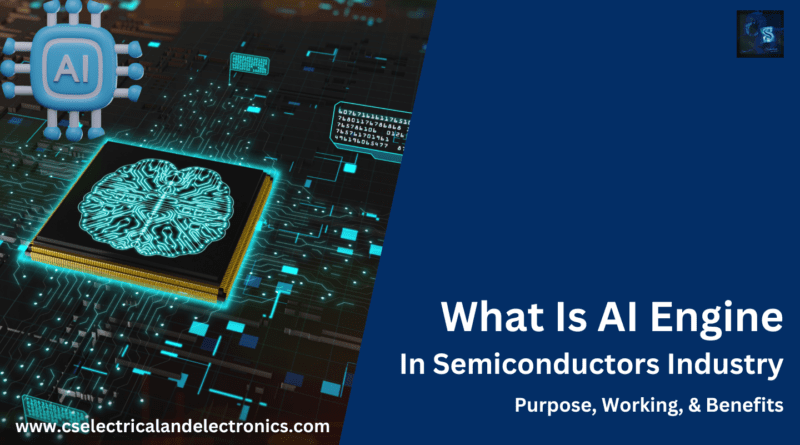What Is AI Engine, Purpose Of AI Engine, Applications Of AI Engine
Hello guys, welcome back to our blog. Here in this article, we will discuss what is AI Engine in the semiconductor industry, the purpose of the AI engine, applications of the AI Engine, and its working.
If you have any electrical, electronics, and computer science doubts, then ask questions. You can also catch me on Instagram – CS Electrical & Electronics.
Also, read the following:
- What Is Battery Swapping Technology, Purpose, Benefits
- First impressions of the Mercedes-AMG GT 63 S E Performance’s looks, interior, powertrain, and features
- What Is Vehicle To Vehicle Communication, Can Help People?
What Is AI Engine
An AI engine is a specialized hardware element created especially to speed up the execution of artificial intelligence workloads in the context of semiconductor technology. These AI engines are often built into system-on-chip (SoC) designs and are prepared for the deep learning algorithms’ high parallelism and computational demands.
The enormous amount of data processing needed for AI applications, which can be difficult for conventional CPUs or GPUs, is handled by AI engines in semiconductors. When compared to general-purpose processors, their ability to execute several operations in parallel with a high degree of precision and efficiency results in much quicker and more power-efficient performance.
These AI engines might come with specialized processing units, including tensor processing units (TPUs), which are well-suited for the matrix operations deep learning algorithms frequently require. To enhance the performance of data-intensive activities, they might also incorporate specialized memory designs, such as high-bandwidth memory (HBM).
The two main categories of AI engines found in semiconductors are those intended for inference and those intended for training AI models.
Large datasets are fed into AI models during training, and their parameters are changed to reduce the discrepancy between the model’s output and the desired output. The amount of processing power and memory bandwidth needed for this procedure is substantial. The flexibility and configurability of AI engines optimized for training are often greater than those optimized for inference, enabling developers to test out various neural network designs and optimization strategies.
Inference, on the other hand, entails applying a learned model to make predictions about fresh data. Although less computationally demanding than training, this method nevertheless calls for powerful computing power. AI engines optimized for inference are built to execute pre-trained models rapidly and effectively, frequently with less power consumption and smaller footprints than those built for training.
Particularly in the areas of autonomous driving, robotics, and smart devices, there has been an increase in the need for AI engines in semiconductors in recent years. AI engines may greatly increase the performance and power efficiency of AI workloads by shifting them from conventional CPUs and GPUs to specialized hardware, opening up new applications and use cases.
Purpose of AI Engine
Artificial intelligence (AI) engines are built into semiconductors to speed up the execution of AI workloads like machine learning and deep learning as well as to enable new applications and use cases that were previously impractical owing to computational constraints.
AI engines are made to process the enormous amounts of data that are necessary for AI applications, which might be difficult for conventional CPUs and GPUs to handle. AI engines may greatly increase the performance and power efficiency of AI workloads by outsourcing AI computations to specialized hardware, enabling real-time inference and quicker model training.
Applications for AI engines include many different ones, including:
- Real-time picture and sensor data processing for autonomous vehicles is made possible by AI engines, enhancing road safety and productivity.
- Robotics: AI-powered engines can provide robots with the computing capacity they need to handle difficult tasks like object recognition, navigation, and decision-making.
- Intelligent functions in smart devices, such as voice recognition, image recognition, and natural language processing, can be enabled by AI engines.
- Medical imaging and diagnostic tools can be developed more quickly thanks to AI engines, allowing for quicker and more precise illness diagnosis.
In conclusion, AI engines in semiconductors are specifically designed to speed up the performance of AI workloads and enable a variety of applications and use cases that were not previously feasible or conceivable.
Applications of AI Engine
There are numerous uses for AI engines in semiconductors in numerous industries. Here are a few instances:
01. Autonomous driving is made possible by AI engines that interpret real-time data from cameras, sensors, and lidar. Tasks including object detection, lane detection, and traffic sign recognition are made possible by these engines.
02. Robotics: AI engines are employed to make it possible for robots to carry out difficult tasks like object recognition, navigation, and decision-making. They are also employed in industrial automation, where robots must be capable of operating in a dynamic environment.
03. Intelligent features in smart gadgets, such as voice assistants, facial recognition, and augmented reality, are powered by AI engines.
04. Medical imaging and diagnostic technologies now include AI engines, allowing for quicker and more precise detection of diseases including cancer, Alzheimer’s, and heart disease.
05. Applications for natural language processing, including chatbots, virtual assistants, and language translation, require AI engines.
06. Finance: Financial applications including fraud detection, risk assessment, and portfolio management all use AI engines.
07. Energy: AI engines are employed in energy applications including managing the power system, maximizing renewable energy, and forecasting energy usage.
All things considered, AI engines in semiconductors are rapidly being used in a variety of industries to enable new capabilities and boost productivity.
Working of AI Engine
The architecture and the kind of AI workload that an AI engine is intended to manage to determine how well it performs in semiconductors. However, the following provides a general understanding of how an AI engine operates:
01. Data preparation: Before the input data can be used by the AI engine, it must first be cleaned up and preprocessed. This could entail activities like feature scaling, data augmentation, and data normalization.
02. Model construction: A machine learning or deep learning framework, such as TensorFlow, PyTorch, or Caffe, is used to design and construct the AI model. The model can be pre-trained or trained on the data as it is being collected.
03. Model optimization: The model has been tailored to the hardware and particular AI engine it is using. To lessen the model’s memory and processing demands, this may entail actions like model compression, pruning, and quantization.
04. Depending on the type of AI workload, the inference or training task is carried out by the AI engine. The pre-trained model is utilized in inference to produce predictions based on fresh data. To increase accuracy, the model is modified during training based on the input data.
05. Output: The AI engine’s output is then sent to the application or system using it. This could entail activities like data visualization, decision-making, or physical system control.
A complex interaction between hardware and software elements, including specialized processing units like tensor processing units (TPUs), memory architectures like high-bandwidth memory (HBM), and software frameworks for machine learning and deep learning, is required for an AI engine in semiconductors to function.
This was about “What Is AI Engine“. I hope this article may help you all a lot. Thanks for reading.
Also, read:
- 100 + Electrical Engineering Projects For Students, Engineers
- 100+ C Programming Projects With Source Code, Coding Projects Ideas
- 1000+ Electronics Projects For Engineers, Diploma, MTech Students
- 1000+ Interview Questions On Java, Java Interview Questions, Freshers
- 1000+ MATLAB Simulink Projects For MTech, Engineering Students
- 500+ Embedded System Projects For Engineer, Diploma, MTech, PhD
- 500+ Projects For Diploma Electrical, Electronics Student, Diploma Project
- 8051 Microcontroller Timers, TCON Register, TMOD Register
Author Profile
- Chetu
- Interest's ~ Engineering | Entrepreneurship | Politics | History | Travelling | Content Writing | Technology | Cooking
Latest entries
 All PostsApril 19, 2024What Is Vector CANoe Tool, Why It Is Used In The Automotive Industry
All PostsApril 19, 2024What Is Vector CANoe Tool, Why It Is Used In The Automotive Industry All PostsApril 13, 2024What Is TCM, Transmission Control Module, Working, Purpose,
All PostsApril 13, 2024What Is TCM, Transmission Control Module, Working, Purpose, All PostsApril 12, 2024Top 100 HiL hardware in loop Interview Questions With Answers For Engineers
All PostsApril 12, 2024Top 100 HiL hardware in loop Interview Questions With Answers For Engineers All PostsMarch 22, 2024Driver Monitoring Systems In Vehicles, Working, Driver Sleepy Alert
All PostsMarch 22, 2024Driver Monitoring Systems In Vehicles, Working, Driver Sleepy Alert








